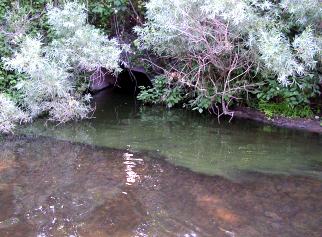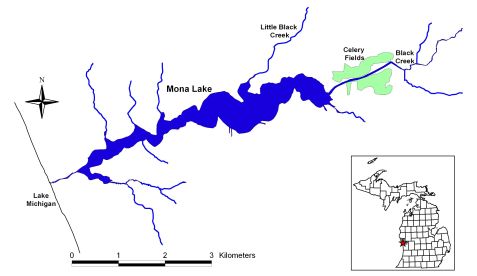Muck Fields as a Source of Phosphorus to Mona Lake

During summer months, plumes of algae-laden water can be seen flowing from the muck fields into Black Creek, presumably carrying high concentrations of phosphorus.
The Mona Lake watershed faces some of the most serious water quality challenges in west Michigan. The two major tributaries to Mona Lake, Black Creek and Little Black Creek, are impacted by too much sediment and high nutrient levels, and have impaired biotic diversity. Phosphorus levels in Mona Lake are very high, in the eutrophic to hypereutrophic range, and have been implicated in potentially toxic blue-green algae blooms in the lake.
Phosphorus source control is a major priority in the Mona Lake watershed. Black Creek has been identified as a major contributor of phosphorus to Mona Lake. Abandoned muck farms used for celery production, but now converted into shallow lakes, abut Black Creek just before it enters Mona Lake. These muck fields may be releasing phosphorus to Black Creek, and consequently, to Mona Lake.
Our goal is to determine to what degree these muck fields serve as a source of phosphorus to Mona Lake.

To accomplish this, we are sampling water quality, including phosphorus concentrations, in Black Creek upstream and downstream of the muck fields. In addition, we are analyzing the sediments in the muck fields for phosphorus content and sorption/desorption dynamics.
Based on the results of this study, we will identify mitigation strategies for controlling any phosphorus coming from the muck fields. Our results and recommendations will be provided to stakeholders for resource management decisions.
Funding for this project was provided by the Michigan Department of Environmental Quality.
Our project partner is the Mona Lake Watershed Council.
Download final project report here
Contacts:
Al Steinman, Project Manager: [email protected]
Mary Ogdahl, Lead Technician: [email protected]

